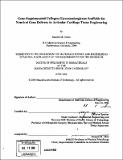Gene-supplemented collagen-glycosaminoglycan scaffolds for nonviral gene delivery in articular cartilage tissue engineering
Author(s)
Capito, Ramille M. (Ramille Marie)
DownloadFull printable version (46.26Mb)
Other Contributors
Massachusetts Institute of Technology. Dept. of Materials Science and Engineering.
Advisor
Myron Spector.
Terms of use
Metadata
Show full item recordAbstract
Three-dimensional scaffolds and growth factors have been shown to be important for articular cartilage tissue engineering. A major problem in using recombinant proteins in vivo, however, is the inability to maintain therapeutic levels over prolonged times due to degradation or diffusion from the defect site. The goal of this thesis was to develop a method to employ type II collagen-glycosaminoglycan (CG) scaffolds for the nonviral delivery of the gene encoding for insulin-like growth factor (IGF)-I, as a novel means to provide a local, elevated, and prolonged release of a therapeutic growth factor via transfection of cells seeded or migrating within the scaffold. In vitro studies were performed to evaluate gene-supplemented CG (GSCG) scaffolds, including: 1) the type of expansion medium to use for growing chondrocytes prior to transfection, 2) methods of incorporating genes within scaffolds, 3) additional incorporation of transfection enhancers, and 4) the use of mesenchymal stem cells (MSCs) as an alternative cell source for articular cartilage tissue engineering. (cont.) The medium used during monolayer expansion not only had a significant effect on subsequent biosynthesis and chondrogenesis in CG scaffolds, but also on gene transfer to chondrocyte monolayers. The expansion medium that resulted in enhanced 3-D biosynthesis and gene transfer to cells in monolayer was used throughout the rest of the studies. Greater plasmid retention within GSCG scaffolds was achieved by chemically cross-linking the plasmid IGF-1 (pIGF-1) to the scaffold (compared to simple plasmid absorption), and resulted in more steady and prolonged IGF-1 overexpression by seeded chondrocytes. Incorporation of a lipid transfection reagent or gelatin nanoparticles encapsulating pIGF-1 significantly enhanced gene expression. The method of gene incorporation and the type of transfection enhancer were important variables that controlled the initiation, amount, and duration of growth factor release. IGF-1 overexpression by cells successfully transfected within GSCG scaffolds also increased biosynthesis of cartilage matrix molecules and chondrogenesis. Finally, MSCs seeded into GSCG scaffolds were able to be successfully transfected and maintained IGF-1 overexpression for at least 2 weeks post-seeding. (cont.) These findings show promise in using GSCG scaffolds for providing a local, prolonged, and therapeutic release of desired growth factors using nonviral transfection methods for tissue engineering or regenerative medicine applications.
Description
Thesis (Ph. D.)--Massachusetts Institute of Technology, Dept. of Materials Science and Engineering, 2006. Includes bibliographical references.
Date issued
2006Department
Massachusetts Institute of Technology. Department of Materials Science and EngineeringPublisher
Massachusetts Institute of Technology
Keywords
Materials Science and Engineering.